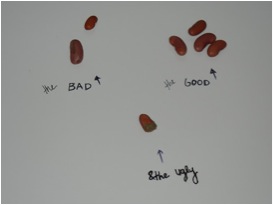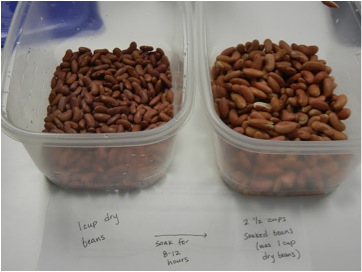By Sara Munson, Boston University Dietetic Intern
“This is my invariable advice to people: Learn how to cook – try new recipes, learn from your mistakes, be fearless, and above all have fun!”
― Julia Child, My Life in France
For many people, the main thing holding them back from cooking at home is the fear of learning how. Here at the Sargent Choice Nutrition Center we want to help you get over this fear by equipping you with some cooking basics. Once you’ve mastered these, you’ll be amazed at how non-threatening most recipes will become – you may even find a passion for cooking! In this post, I’d like to take the opportunity to teach you how to master the process of preparing dried beans.
Whether they are in a delicious dish of red beans and rice, baked to perfection in a classic bean pot, or simply topping off a salad in the dining hall, beans are a tasty addition to any meal. I recently had the chance to present on the wonders of beans and the easy ways to prepare them in Sarah Butler’s Vegetarian Nutrition & Cooking class.
Why buy dried beans?
Beans, whether canned or dried, are a great source of protein, fiber, and other nutrients. If you are a vegan or vegetarian, beans should play a major role in your diet to ensure that you are getting the nutrients your body needs. Learning how to soak and cook dried beans will save you money and be healthier in the long run.
- One 19 oz can of beans contains just 2 cups of beans. For about the same price, you can buy 7.5 cups (once cooked of dried beans.
- Canned beans can cost around $0.70 per cup while dried beans cost about $0.20 per cup. Buying dried beans can save you $0.50 per cup and if you are eating beans regularly, these savings add up! (Dried beans can also be found in bulk, however these may be more expensive than bags of beans since bulk items are often organic.)
- A serving of canned beans can have around 340 mg of sodium while dried beans only contain 20 mg of sodium per serving. (For info on sodium and health visit: http://www.cdc.gov/salt/)
How to Prepare Dried Beans
Preparing dried beans involves just a few easy steps. Beans can be purchased in your local grocery store or even at some farmer’s markets. When choosing your beans, look for smooth, firm, brightly colored beans. Wrinkled, broken beans should be avoided.
Dried beans will expand to about 2.5 times their size so measure accordingly.
- To begin, pour out the amount of beans you will be using onto a flat plate or surface. You will want to take a second to look through the beans and sort out any shriveled beans or small stones that may have gotten mixed in.
- Next, put the beans into a container (keeping in mind as they soak, they will expand). Add water to the container, about 3 times the amount of beans. Cover the container and leave to soak for 8-12 hours. Do not add any salt to the beans at this point; it will prevent the beans from fully expanding.
- After several hours, the beans should be expanded. Strain and rinse the beans until the water runs clear. Rinsing the beans will help to prevent unwanted gas that may be a side effect of eating beans! (Here’s a great explanation on why beans cause flatulence)
- Once rinsed, place the beans in a large pot and cover with water. Remove any beans that remain floating. Bring the pot to a boil and then reduce to a simmer. Cook time will depend on the type of bean you are using but should be between 1-2 hours.
- When a bean can be easily crushed between your tongue and the roof of your mouth, they are done! Discard the cooking water to further remove gas causing agents.
Cooked beans can be used for multiple dishes including salads, pasta dishes, soups, and burritos!
Storing Beans
Once cooked, beans should either be refrigerated or frozen. Cooked beans should last in the refrigerator for up to 5 days. Frozen beans should be stored in small servings to make thawing easier. Once thawed, do not refreeze.
Bean Variety
To keep your menus fresh and interesting, try experimenting with different kinds of beans! There are many varieties beyond kidney beans, black beans, and pinto beans that offer great flavor and nutrients. Be sure to look up cooking times for each variety as they may differ.
- Lentils are fast and easy (No pre-soaking required with these beans!!). Lentils make a great ground meat substitute in dishes such as Sloppy Joe’s and Veggie Burgers.
- Small Reds are popular in the Southern favorite red beans and rice.
- Cranberry Beans are popular in Italy and make a great warm salad.
- Maine Yellow Eyes make delicious baked beans!
If you would like to learn even more about the wonders of beans, check out this site: http://www.usdrybeans.com/
Inspired to cook with beans? Take a stab at a few of our recipes.
– Easy Vegan Bean Chili
– Black Bean Burgers
– Black Bean Vegetarian Chili
– Whole Wheat Penne with Roasted Garlic, Tomatoes and White Beans
– Smoky Corn & Black Bean Pizza
– Smoky Black Bean & Cheddar Burrito with Baby Spinach

